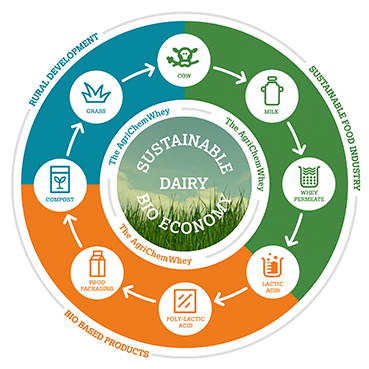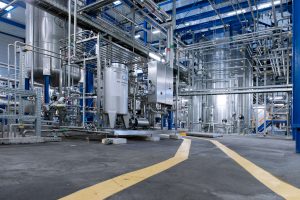Whey Permeate (WP) and De-lactosed Whey Permeate (DLP) are major by-products of dairy processing and represent a key challenge for the dairy industry due to a lack of reliability in current disposal routes and represent a sustainability bottleneck for the expansion of milk production in Europe in the “post-milk-quota era”. AgriChemWhey will seek to build a first-of-a kind, industrial-scale biorefinery with integrated symbiotic industrial and agricultural value chains that will have capacity to valorise over 25,000 tonnes (100% dry matter) per annum of excess WP and DLP to several added value products for growing global markets including lactic acid, polylactic acid, minerals for human nutrition and bio-based fertilisers. This will be achieved through a coordinated investment process and development path to realise the Flagship plant, representing the first major industrial venture to convert residues from food processing, as second generation feedstocks, to value added bio-based products. The Flagship will prove the techno-economic viability of the innovative WP/DLP-to-lactic acid biorefinery technology which is based on a unique fermentation process. AgriChemWhey aims to advance this innovative technology through the integration, optimisation and scale-up of the processes; reducing the fermentation time to a 12-hour process, optimising the upstream processing of DLG and WP, and optimising the downstream steps for simplified novel LA purification to industrial scale. This will establish a new value chain for industrial symbiosis with other local actors for the production of high value sustainable food and feed (including high quality mushrooms) products from other side streams, as an enhanced circular bioeconomy approach to agriculture and agri-food waste. This offers society and industry the opportunity for greater resource efficiency – less food waste, more products from the same starting material (milk), and integration of food and nonfood material production. AgriChemWhey will also develop a blueprint of an economic sustainability concept and replication plans for other regions across Europe, thus maximising both short and long term impacts, contributing towards the development of the European bioeconomy to promote rural growth, competitiveness and job creation, and aligning with European sustainability targets.

Objectives
The overall objective of AgriChemWhey is to build a first-of-a kind industrial-scale biorefinery with integrated symbiotic industrial and agricultural value chains to valorise dairy waste. Specific objectives include:
-
Scale up from Demo-scale (75 MT per capacity annum) to commercial scale (20,000 tonnes per annum capacity) of biorefinery technology for the conversion of food processing residues to food, feed and polymer grade LA and confirming techno-economic viability of the integrated biorefinery approach.
-
Optimise process technologies to reduce the time it takes to produce LA from WP and DLP, increase the yield from 85% to 95% and improve the purification process so that a high purity LA can be achieved using a simplified and energy efficient downstream process.
-
Establish a new WP and DLP to LA and PLA value chain based on increased surplus WP and DLP from the dairy processing industry and create a major new second generation value chain for the growing global LA and PLA market.
-
Establishing industrial symbiosis with local partners to valorise gypsum, calcium phosphate and fermentation residue (bacterial biomass) side streams arising from WP and DLP to LA process for agricultural use and human nutrition to improve sustainability and boosting economic return on investments.
-
Ensure successful commercial operation of the biorefinery including plans to increase LA production volumes and economies of scale, new capabilities to produce PLA and higher added value valorisation of side-streams and the development of a blueprint for replication of the AgriChemWhey model in other regions across Europe.

Impact
AgriChemWhey represents a significant step change in current whey processing techniques and industrial symbiosis that inspires the creation of new value chains. While it is focused on commercialising current and future whey “side streams” to improve resource efficiency, it has the capability to enhance the sustainability of businesses from three different sectors; Dairy, Chemicals and Polymers, and Horticulture. It will underpin the growth of a more sustainable European dairy industry in the post milk quota era through innovation and knowledge exchange, serving as a model for sustainable growth in dairy output in the EU and globally.
The key outcomes of the AgriChemWhey project and the impacts beyond the end of the project include:
-
Rural community development through rural job creation.
-
Securing the future for dairy farming families through an increase in dairy farmer incomes and protection against income volatility.
-
Regional development, in regions facing industrial transition, through the replication of between 1 to 5 AgriChemWhey-like Plants arising from private investments up to 325 MEUR.
-
Positive impact on EU trade balance through greater resource efficiency resulting in the reduction of EU LA imports (80,000 tonnes per annum) and the potential to turn Europe into a net exporter of LA.
-
Industrial symbiosis for the creation of new value chains.
-
Providing inspiration to society and industry to support the growth and competitiveness of a European circular bioeconomy and trans European cooperation.
-
CO2 savings, from 18,000 tonnes CO2eq/year up to 89,000 tonnes CO2eq/year (based on 1 to 5 AgriChemWhey like plants).
Would you like to know more about AgriChemWhey? Get in touch.